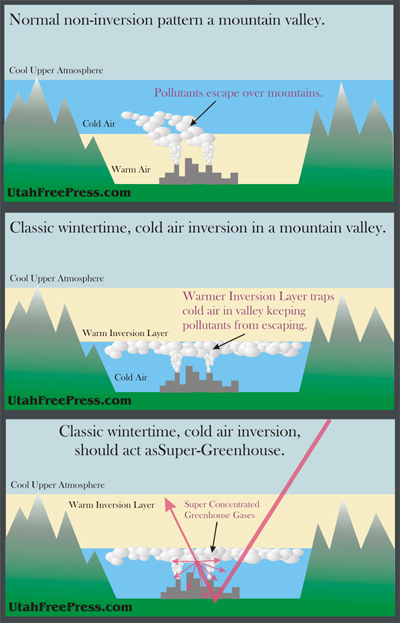 For many years now, I have been batting around some questions in my head regarding Manmade Global Warming Theories (MGWT) and the possible effect of very high concentrations of Greenhouse Gases during periods of Meteorological Thermal Inversions (MTI) that are persistent during the winter months in many locations here in Utah. It seems to me that these periods of inversion where cold air get’s trapped below warm air essentially capturing large amounts of pollutants in the process would create a perfect test case for scientists to study the effects of Greenhouse Gases on a large scale but in a confined, definable environment.
For many years now, I have been batting around some questions in my head regarding Manmade Global Warming Theories (MGWT) and the possible effect of very high concentrations of Greenhouse Gases during periods of Meteorological Thermal Inversions (MTI) that are persistent during the winter months in many locations here in Utah. It seems to me that these periods of inversion where cold air get’s trapped below warm air essentially capturing large amounts of pollutants in the process would create a perfect test case for scientists to study the effects of Greenhouse Gases on a large scale but in a confined, definable environment.
For those not familiar with “Inversions,” they most commonly occur in mountain valley areas during the winter months. While the cause of inversions may vary somewhat, they are generally produced when warmer air mass moves over the top of a cooler air mass. While this is a common metrological event, Inversions can become persistent when this occurs in mountainous regions where the colder air in a valley can become trapped as the mountains help prevent the cold air mass from moving along and eventual mixing with the warmer air aloft.
Because this cold air is essentially trapped near the ground, large amounts of pollutants quickly begin to build up in the inversion bubble, if the inversion occurs over a densely populated or industrialized area. While the average global concentrations of one primary Greenhouse Gas, CO2 (Carbon Dioxide) for December 2010 was 389.69ppm during the most recent Inversion event in Salt Lake City, Utah CO2 levels climbed to over 600ppm. Intuitively, one would expect that such high concentrations of CO2 in the Salt Lake Valley would cause the temperatures in the area to rise significantly as CO2 levels increased; so why didn’t they? Should we not see a Super Greenhouse Effect in such areas?
Science is as much about being able to predict the future as it is about creating a general understanding of the world around us. If we truly understand the role the CO2 plays in trapping converted solar radiation from the ground in the atmosphere, then we should be able to make reliable predictions about a rise in air temperature during an inversion in Salt Lake City due to rising Greenhouse Gas levels. Even if such a rise is not significant enough to cause the stalemate between the cool lower air and the upper warm air to be broken by this increase, the data should show a strong correlation between temperature and Greenhouse Gas concentrations.